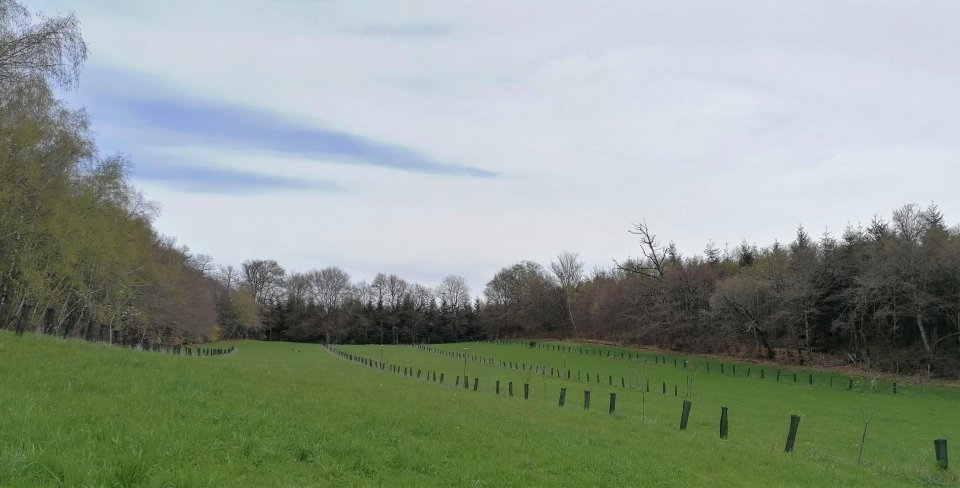
With a view to food self-sufficiency and environmental education, the Raulhac farm, a social welfare centre set up in 2010 in the commune of Neuvic, Corrèze, has planted two intra-plot agroforestry plots in a relatively unspoilt semi-natural setting (ZNIEFF) in Haute-Corrèze. During the 20th century, the rural exodus and the development of forestry led to the disappearance of numerous meadow orchards, deciduous trees, wetlands and peat bogs in the surrounding area, replaced by plantations of Douglas Fir and Norway Spruce bordering the hamlets of Raulhac and Forêt noire. The prospect of clearcutting these neighbouring plantations in the short- to medium-term prompted the Strumpler family to plant copses and hedges of fruit, forest and field trees around the agroforestry plots, which are themselves intended to produce fruit, hay and cereals for breadmaking. Together, they create the ecological habitats needed by beneficial organisms and a rural-landscape framework for their project to provide food, education and social welfare.
- For adapting to climate change : creating microclimates and boosting the resistance of crops to increasingly frequent droughts in the Corrèze, and introducing nitrogen-fixing tree species.
- For biodiversity : creating ecological continuities between natural areas of ecological, faunistic and floristic interest (ZNIEFF) and improving the general condition of the soil.
- For the local area : integrating these developments into local supply chains (fruit production, heating, firewood, use in livestock farming, etc.)
Begun in 2018, the works consisted in :
- Planting 2 330 plants including an alternating mix of fruit trees, shrubs and bushes of various species suited to the soil and climate context (apple trees, berries, in particular blueberry bushes). The planting scheme included 2 200 linear metres of concentric arcs (800 trees), hedges and copses along the edges (1 300 trees, 4.8 ha) and 240 trees within the plot (700 linear metres, 1.5 ha).
- Planting intercropped cereal crops (buckwheat) after a rest period on plots previously used as hay fields
The project leaders also encourage biodiversity by creating flower meadows, insect shelters and bird perches on the farm. The farm’s produce is compliant with organic farming specifications.
BENEFITS REGARDING TARGETED ADAPTATION ISSUES
- Soil regeneration and stabilisation via the root systems of trees and shrubs.
- Improved shade and windbreak effect on the farm.
OTHER BENEFITS
- Socio-economic : diversification of farm income by combining the sale of fruit and wood in a local supply chain.
- Climate change reduction : carbon sequestration via the planted trees.
- Stabilisation of fodder yields.
BENEFITS FOR BIODIVERSITY
- Safeguarding the local genetic heritage and plant resilience by encouraging the use of grafts of old apple-tree varieties.
- Increasing the pool of pollinating insects through the broad variety of shrubs and the ground cover.
- Developing climate change adaptation; improving risk management and resilience
- Better protection and restoration of coastal ecosystems
- Flood peak reduction
- Increase infiltration / Water storage
- Increasing infiltration
- Reduce drought risk
- Reduce flood risk
- Reduce risk of damages from drought
- Reduce run-off
- Reducing temperature at meso or micro scale
- Developing climate change mitigation
- Carbon sequestration and storage
- Restoring ecosystems and their functions
- Increase Biodiversity
- Increased cultural richness and biodiversity
TECHNICAL ASPECTS AND PROJECT DESIGN
- Protecting the plants from deer by protecting the trunks and, when close to woodland, setting up 2-metre-high fences.
- Protecting the roots from mole rats by burying metal baskets of sufficient size to support the root system until it reaches maturity and by setting up nest boxes and piles of wood to encourage the proliferation of natural predators (birds of prey, snakes).
- Managing water resources : creating a pond and setting up a « drip » watering system suited to the local climate. The effect of drought will be limited by mowing the meadow late, maintaining grass cover on the strips and mulching the plants with wood shavings.
- Helping the trees to become established by planting them young, ideally at the seedling stage. If pests are too abundant, opting for more resistant (but more expensive) mature trees.
STAKEHOLDER COMMITMENT
- Contacting a farmers’ union : for example, the blueberry growers’ union offers training courses in Corrèze and Limousin on how to design an irrigation system that is more resistant to drought.
- Finding out about the subsidies available : the Corrèze department finances anti-insect netting, for example.
- Working with local educational establishments to facilitate flora and fauna surveys.
MONITORING AND REPLICABILITY OF THE ACTION
- Experimenting with different varieties to test their resilience in relation to soil characteristics and rainfall. The Vergers de Raulhac (sandy-loam soil) observed that Oleaster and Arbutus did not take well, while Alder showed better resistance.
- Assessing in order to to adapt : setting up a regular monitoring and assessment system supported by technical and academic experts ensures that the project is able to evaluate itself and adapt to improve its effectiveness.
- Passing on experience : encouraging the hosting of groups of young people and trainees to share knowledge about the innovative systems developed by the Vergers de Raulhac (anti-mole rat baskets, geoclimatic greenhouse, etc.).
- Ensuring economic viability : considering how to diversify the farm’s activities by combining several types of agricultural production and possibly additional activities such as social welfare.
- Enhancing self-sufficiency and anticipating possible losses through cycles of bench or field grafting of fruit trees.
Gabrielle Strumpler vergers@raulhac.org
Nature 2050 – Programme & Fonds nature2050@cdc-biodiversite.fr
